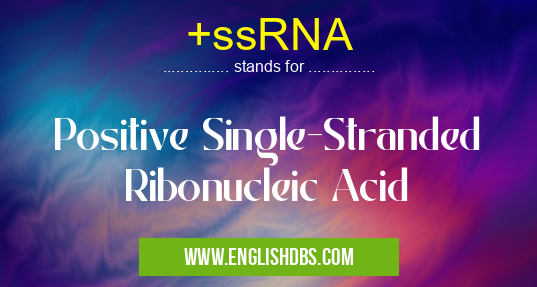What does +SSRNA mean in MEDICAL
Positive Single-Stranded Ribonucleic Acid (+ssRNA) refers to a specific type of RNA molecule that plays a crucial role in the replication and genetic information transmission of certain viruses.

+ssRNA meaning in Medical in Medical
+ssRNA mostly used in an acronym Medical in Category Medical that means Positive Single-Stranded Ribonucleic Acid
Shorthand: +ssRNA,
Full Form: Positive Single-Stranded Ribonucleic Acid
For more information of "Positive Single-Stranded Ribonucleic Acid", see the section below.
What is +ssRNA?
+ssRNA is a positive-sense, single-stranded RNA molecule. This means that its sequence is complementary to the mRNA (messenger RNA) of the host cell and can directly translate into viral proteins without the need for an intermediate strand. It serves as the genetic material for some viruses, such as poliovirus and tobacco mosaic virus.
Characteristics of +ssRNA
- Positive-sense: The RNA strand is directly translatable into viral proteins.
- Single-stranded: Consists of a single strand of RNA nucleotides.
- Polarity: The RNA strand has a 5' cap and a 3' poly-A tail, indicating its polarity.
- Replication: Replicates using an RNA-dependent RNA polymerase enzyme.
Role in Viral Replication
+ssRNA viruses use a replicase enzyme to synthesize a complementary negative-stranded RNA molecule, which then serves as a template for producing multiple positive-stranded RNA molecules. These positive strands can then translate into viral proteins or serve as new genomes for the progeny viruses.
Essential Questions and Answers on Positive Single-Stranded Ribonucleic Acid in "MEDICAL»MEDICAL"
What is ssRNA?
Positive Single-Stranded Ribonucleic Acid (ssRNA) is a type of RNA molecule that comprises a single strand of nucleotides with a positive polarity. It contains adenine (A), cytosine (C), guanine (G), and uracil (U). ssRNA serves as the genetic material in some viruses, such as the tobacco mosaic virus and the poliovirus.
What is the significance of the positive polarity in ssRNA?
The positive polarity of ssRNA means that the sequence of the RNA strand is identical to the coding sequence of the corresponding protein. This allows the RNA to be directly translated by the ribosome without the need for a complementary strand.
What is the role of ssRNA in viral replication?
In viruses, ssRNA plays a crucial role in replication. The viral RNA polymerase enzyme uses the ssRNA as a template to synthesize complementary strands of RNA, which are then used to produce new copies of the viral genome. The newly synthesized viral genomes are then packaged into new viral particles.
Is ssRNA found only in viruses?
No, ssRNA is not exclusively found in viruses. It is also present in some non-viral organisms, such as certain bacteria and plants. In these organisms, ssRNA serves various functions, including gene regulation and RNA interference.
Final Words: +ssRNA is a type of RNA molecule found in some viruses. It is positive-sense and single-stranded, allowing for direct translation into viral proteins. The replication of +ssRNA viruses involves the synthesis of a complementary negative strand, which serves as a template for producing more positive strands. Understanding the properties and behavior of +ssRNA is crucial for studying viral infections and developing antiviral therapies.
